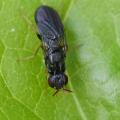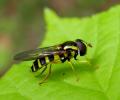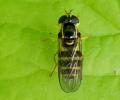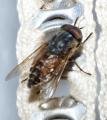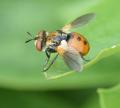Diptera.info :: Identification queries :: Diptera (adults)
Who is here? 1 guest(s)
|
Bromophila caffra
|
|
| crex |
Posted on 16-02-2008 21:29
|
|
Member Location: Sweden Posts: 1996 Joined: 22.05.06 |
I got permission from Sven-Erik (from Finland) to show this fly which he took on Hippopotamus dung at Tongabezi lodge, near Livingstone City, Zambia nov/dec 2007. Yeah, I also saw the smaller one in the photo.
crex attached the following image: 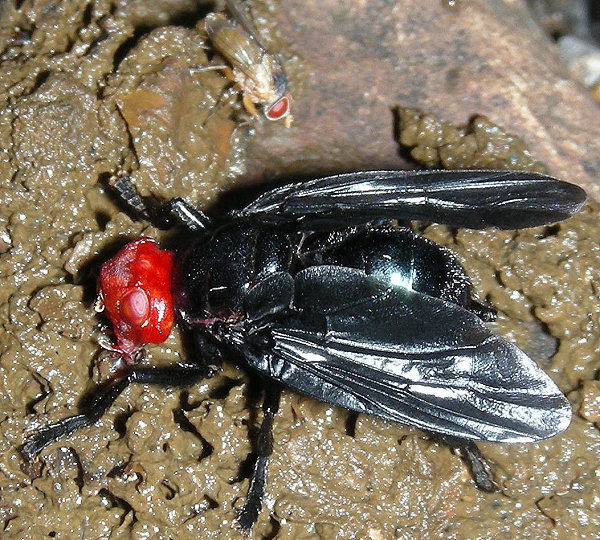 [176.06Kb] Edited by crex on 16-02-2008 23:59 |
|
|
|
| Xespok |
Posted on 16-02-2008 21:36
|
|
Member Location: Debrecen, Hungary Posts: 5550 Joined: 02.03.05 |
The smaller one seems to be Atherigona or close, Muscidae. As for the larger one my guess would be somewhere around Hipodermatidae. Gabor Keresztes Japan Wildlife Gallery Carpathian Basin Wildlife Gallery |
| Gerard Pennards |
Posted on 16-02-2008 21:38
|
|
Member Location: Amersfoort Posts: 1914 Joined: 07.06.04 |
Nope, the big one belongs to the family Platystomatidae and is named Bromophila caffra!  Greetings, Greetings, Gerard Pennards |
|
|
|
| Xespok |
Posted on 16-02-2008 21:40
|
|
Member Location: Debrecen, Hungary Posts: 5550 Joined: 02.03.05 |
You are right, this can not be a Calyptrate fly, the tarsal segments should have alerted me. Actually this looks quite simiar to Platystoma, save for the head and the overall coloration.
Gabor Keresztes Japan Wildlife Gallery Carpathian Basin Wildlife Gallery |
| Tony Irwin |
Posted on 16-02-2008 21:42
|
|
Member Location: Norwich, England Posts: 7193 Joined: 19.11.04 |
Well - my first thought is Thyreophora cynophila - something I never thought I'd ever see! (I think it's supposed to be extinct!) EDIT: I'll happily defer to Gerard on this. but it's a great example of convergent evolution - see http://de.wikiped...nsenfliege Edited by Tony Irwin on 16-02-2008 21:48 Tony ---------- Tony Irwin |
|
|
|
| Gerard Pennards |
Posted on 16-02-2008 21:48
|
|
Member Location: Amersfoort Posts: 1914 Joined: 07.06.04 |
Yes Tony, would have been great!! But that one is extinct isn't it? And Thyreophora cynophila had clear wings with only a black dot in it, so unfortunately....... I keep with my former answer!   Greetings Greetings, Gerard Pennards |
|
|
|
| jorgemotalmeida |
Posted on 16-02-2008 21:49
|
|
Member Location: Viseu - PORTUGAL Posts: 9296 Joined: 05.06.06 |
This is the fabulous Bromophila caffra. i TALKED about this fly before!!!!  See the favourite flies thread. See the favourite flies thread.  see here >>>>> http://diptera.in...owstart=20 check the penultim post. 
Edited by jorgemotalmeida on 16-02-2008 21:53 |
| jorgemotalmeida |
Posted on 16-02-2008 21:50
|
|
Member Location: Viseu - PORTUGAL Posts: 9296 Joined: 05.06.06 |
there is in SOuth Africa as well.  |
| crex |
Posted on 16-02-2008 23:48
|
|
Member Location: Sweden Posts: 1996 Joined: 22.05.06 |
Thank you all!  |
|
|
|
| Nosferatumyia |
Posted on 17-02-2008 09:00
|
|
Member Location: Posts: 3404 Joined: 28.12.07 |
I must confirm previous determinations while Andy Whittington is offline: yes, it is Bromophila caffra Loew (Platystomatini), and the picture itself, indeed, is fabulous! The fly is famous not only because it is one of the largest (but not longest!) platystomatids at all, but because it has no ocelli at all, so it was in the Pyrgotidae for a long time...
Val |
|
|
|
| crex |
Posted on 18-02-2008 14:06
|
|
Member Location: Sweden Posts: 1996 Joined: 22.05.06 |
Is anything known about it's biology? Googling didn't reveal much. I am also curious about why it looks like it does. Could it be some kind of mimicry? The first time I saw this photo I wondered if it might be a joke and that it was a plastic toy fly  |
|
|
|
| Nosferatumyia |
Posted on 18-02-2008 15:09
|
|
Member Location: Posts: 3404 Joined: 28.12.07 |
Like in most other Platystomatini close to Platystoma, almost nothing is known what larvae inhabit, probably soil reach of humus, roots, etc. Platystoma euphorbiae Enderlein was originally reared from rotten plants of some succulent Euphorbia on Canary Is. like what grubs like. Adults, especially females, are usually attracted by dung. (In the case of Brimophila, of elephant's and hyppo's megadung... I myself never collected in palaeotropics, so have no personal observations. Val |
|
|
|
| Andrew Whittington |
Posted on 27-10-2008 10:23
|
|
Member Location: Snowdonia Posts: 108 Joined: 30.01.07 |
Hi everybody ... I'm back on line again. Yes, B. caffra is correct, it is the only species in the genus, defined as Valery says by the lack of ocelli in the adult flies (scars are sometimes visible where the ocelli should be), red (plastic looking) head, black body and wings. Adults vary considerably in size, specimens ranging from 12 - 22mm (body length) and 24 - 50 mm (wing span). This species is distributed along the easter seaboard of the African continent from Kenya southwards , arcing out across Zambia, Zimbabwe, Namibia, Botswana and South Africa. Our knowledge of larval habits is very rudimentary. There appears to be an association with the roots of Terminalia trees (Combretaceae), from which the larvae sequester various toxic compounds (probably cyclic triterpenes) possibly for defense. This may render the adults toxic too, as a defense against predation - not a thoroughly tested hypothesis. Adults are slow moving and ponderous ... and photogenic! Edited by Andrew Whittington on 27-10-2008 10:27 -----o0o----- Andrew E. Whittington https://flyevidence.co.uk/ |
|
|
|
| Jump to Forum: |


